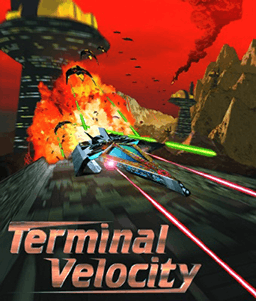Terminal Velocity (video game)
| Terminal Velocity | |
|---|---|
 | |
| Developer(s) | Terminal Reality |
| Publisher(s) | 3D Realms MacSoft |
| Distributor(s) | FormGen |
| Engine | Photex Terrain Engine 1 |
| Platform(s) | MS-DOS, Mac OS, Windows 95 |
| Release date(s) |
|
| Genre(s) | Simulation |
| Mode(s) | Single player, Multiplayer |
| Distribution | Floppy disk, CD-ROM |
Terminal Velocity is a simulation video game developed by Terminal Reality and published by 3D Realms for MS-DOS and Windows 95 and MacSoft for Mac OS. It is an arcade-style flight combat game, with simpler game controls and physics than flight simulators. It is known for its fast, high-energy action sequences, compared to flight simulators of the time.
Terminal Reality also developed a similar game, Fury3, published that same year by Microsoft. It used the same game engine (Photex + Terrain Engine 1) and basic game mechanics, but was designed to run natively on the new Windows 95 operating system. Though considered to add little to the gameplay of Terminal Velocity,[1] Fury3 spawned an add-on pack, F!Zone, as well as a sequel, Hellbender.
Gameplay
The player can fly at low speeds without falling. The player's craft also has no inertia, meaning its course can be changed instantly. There are seven different weapons, ranging from guns, blasters and rockets to homing missiles and a rare secret weapon, and only the first blaster type will never run out of ammo. Additionally, it possesses powerful afterburners that allow it to move at very high speed, which is useful in order to evade attacks, but sacrifices the ability to return fire temporarily (they can be selected like weapons, and if they are, the fire button will ignite the afterburners). The craft is able to survive some hits, and even some collisions with the terrain, including tunnels.
Each of the 27 missions consists of several objectives, e.g. enemies which must be destroyed, tunnel entrances and exits, mere checkpoints, and an extraction point.
Design
Terminal Velocity was co-produced by Tom Hall. The main programmer of the game was Mark Randel, the former lead programmer of Microsoft Flight Simulator. At its launch, the game's all-digital soundtrack, frame rates, external environments, and ability to fly through tunnels and into underground caverns set it apart from the rest of its genre.
Terminal Velocity was released as both a floppy disk and a CD-ROM version. The CD-ROM version improved upon the floppy version with 70 MB of extended pre-rendered 3D cut scenes, a bonus hidden planet, higher image resolution (including more detailed textures) and support for 8-player network multiplay. The Macintosh port was published separately by MacSoft.
Plot
The story is set in the year 2704, when the ASFAR (Alliance of Space-Faring Alien Races), of which Earth is a member, suddenly turns against Earth and their fleet ravages the planet, starting a war. The player flies a powerful starfighter, the TV-202, in a series of missions to defeat the enemy. In Episode 3, the player learns that a huge supercomputer known as X.I. (Xenocidic Initiative), located on Proxima Seven, is responsible for the war. Their final mission is to eliminate it. A hidden mission can take place after the main plot only in the CD ROM version where the player must investigate a sudden metamorphosis of an unknown nearby planet and destroy the force that changed the face of the planet. It is revealed here that this force drove a man named Sy Wickens into insanity, and how the X.I. Supercomputer had "accidentally" digitized Sy Wickens' persona.
Episodes
The game has three episodes, the first of which was distributed as shareware. Each episode features three different worlds, making a total of nine levels. The CD ROM version contains the hidden planet, bringing the total to ten in the CD ROM releases.
References
External links
| ||||||||||||||||||